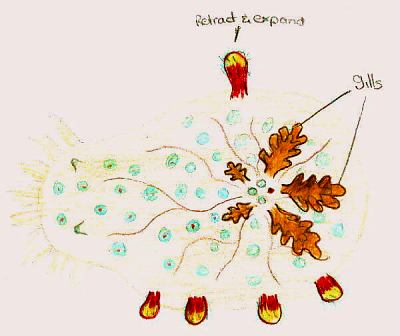Spartacus - the Straddie blob
March 14, 2002
From: Lisa Miller


Hi! Just wondering if you could help me. I work at Kedron State High School in Brisbane [Queensland], and our Year 12 Biology students have just returned from a camp on Stradbroke Island [Moreton Bay, southern Queensland, Australia]. One of the girls found an interesting mollusc that we are having trouble identifying. (The kids have named it "Spartacus") It was on bare sand near Point Lookout, about 200m from a rocky outcrop that has heaps of rock pools. We are fairly certain it may have been washed up from these pools or maybe even from the mud flats and sea grass beds further down the island at Dunwich.
I have include pictures that were sketched of it, and if our photos turn out I may post them by the end of the week. Any help with this would be greatly appreciated, as our students this year are incredibly eager to learn.
Thanks,
Lisa Miller
Kedron State High School
Park Road, Wooloowin, 4030
limil9@kedronshs.qld.edu.au
Miller, L., 2002 (Mar 14) Spartacus - the Straddie blob. [Message in] Sea Slug Forum. Australian Museum, Sydney. Available from http://www.seaslugforum.net/find/6431Dear Lisa,
Your 'blob' is easily identifiable from the drawings. It is a nudibranch called Kalinga ornata which lives off-shore on sandy, or muddy-sand bottoms. Because of where it lives we don't know much about it, most animals that have been found, are like yours, washed ashore, probably after storms and feeling very sick and sorry. However Mary Jane Adams sent some wonderful photos to the Forum of Kalinga 'in the wild'. In its own environment it a much more beautiful and graceful animal - if rather peculiarly shaped - than the blob it looks like when washed ashore.
If you look at the other messages and photos of it on the Forum, you will see we have a number of records of it washing ashore in northern New South Wales and southern Queensland. We know very little about its biology and natural history - we don't even know what it feeds on, but its very broad oral veil with sensory tentacles along the edge suggest it is searching for something in the sand. Kalinga is one of a group of unrelated sea slugs with special adaptations for living in 'soft bottom' muddy-sand environments. If you have a look at the page for Euselenops luniseps you will see a link to a page where I discuss some of the adaotations they have evolved for this special environment.
Best wishes,
Bill Rudman
Related messages
-
Kalinga ornata from NSW, Australia
From: Kristy Nash, November 17, 2009 -
Kalinga ornata from Singapore
From: Samson Tan, November 14, 2007 -
Re: Kalinga ornata from New South Wales
From: Lyn Cleary, December 5, 2003 -
Kalinga ornata from deepwater off Hawaii
From: Dr. Christopher Kelley, May 2, 2002 -
Kalinga ornata from Hong Kong
From: W.B. Rudman & B. W. Darvell, February 2, 2002 -
Re: Living Kalinga ornata
From: Andy Woerner, May 26, 2001 -
Living Kalinga ornata
From: Tim Hochgrebe, December 18, 2000 -
Kalinga ornata from Papua New Guinea
From: Mary Jane Adams, December 2, 1999 -
Kalinga ornata from New South Wales
From: Ann Lawson, November 18, 1999 -
Re: Kalinga ornata
From: Richard Willan, November 18, 1999
